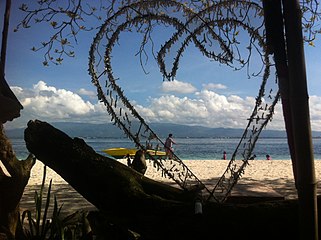Great Santa Cruz Island
Great Santa Cruz Island is a small inhabited island in Zamboanga City in the southern region of the Philippines that is famous for its pink coralline sand.[2] The island, located 4 kilometres (2.49 mi) south of downtown at the Santa Cruz Bank in the Basilan Strait, boasts the only pink sand beach in the Philippines. The color of the sand comes from the pulverized red organ pipe coral from eons of surf erosion mixed with the white sand.[1]
The pink sands of the island | |
.svg.png) Great Santa Cruz Island Location within the Philippines | |
| Geography | |
|---|---|
| Location | Santa Cruz Bank, Basilan Strait |
| Coordinates | 6°51′55″N 122°3′45″E |
| Archipelago | Santa Cruz Islands |
| Adjacent bodies of water | |
| Length | 2.6 km (1.62 mi) |
| Width | 1.5 km (0.93 mi) |
| Coastline | 6.6 km (4.1 mi) |
| Administration | |
| Region | Zamboanga Peninsula |
| City | Zamboanga City |
| Demographics | |
| Population | Unknown |
| Ethnic groups | Bajau people[1] |
The island started to become popular since the 1970s and early 1980s when it was frequented by German, Japanese and Italian tourists. Recently, there's an upsurge of tourists that has been recorded due to its rising popularity as one of a handful of Pink Sand Beaches in the World and is the only one in Asia. In 2017, it was recognized by National Geographic as one of the 21 Best Beaches in the World.[3] [4]
Conservation
The Great Santa Cruz Island together with Little Santa Cruz Island are protected areas in Region 9 of the Philippines. Jointly called the Great and Little Sta. Cruz Islands Protected Landscape & Seascape, it was declared as such on April 23, 2000 with the signing of Proclamation No. 271. The park has a total area of 1,877 hectares (4,640 acres).[5]
Recent illegal coral reef mining has destroyed most of Great Santa Cruz Island's vast coral reef population leaving the former colorful corals as dead skeletal reefs.[1][4] The city government of Zamboanga is planning to improve the island for the preservation, protection, conservation and rehabilitation of the island's ecosystem. The plan also involves developing the island for ecotourism. The improvement would include rehabilitating the present structures on the island. New infrastructures that need to be constructed would be low in profile using materials indigenous to the area, in hope of lessening its impact to the environment. The development plan is expected to be completed in 3 to 5 years time.[6]
Getting to the island
A trip to the island is booked inside Paseo del Mar.
Gallery
- Welcome sign
- An organ pipe coral from offshore, the coral that gave the sand its pink color
- Corals
- Zamboanga City proper as seen from the island
- Marine life
- Transportation to the island
- Pink sands of the island
- View of the island
 The heart-shaped figure near the "Welcome sign"
The heart-shaped figure near the "Welcome sign"
See also
- List of protected areas of the Philippines
- List of islands in the Philippines
References
- "Pink Sand Beach". Zamboanga.com. Retrieved on 2012-04-12.
- "Islands of Zamboanga City - Philippines". Zamboanga.com.
- "21 Best Beaches of the World". nationalgeographic.com. Retrieved on 2017-01-18.
- "Zamboanga City: the Great and Little Santa Cruz Islands". En Route by Ironwolf. Retrieved on 2012-04-12.
- "Protected Areas of Region 9" Archived 2012-03-20 at the Wayback Machine. Protected Areas and Wildlife Bureau. Retrieved on 2012-04-08.
- Covarrubias, Sheila. "City envisions Sta. Cruz"les as ‘island-ecosystem’". Zamboanga, Asia's Latin City. Retrieved on 2012-04-09.
External links

- Great Santa Cruz Island at OpenStreetMap
- Great Santa Cruz Island Guide